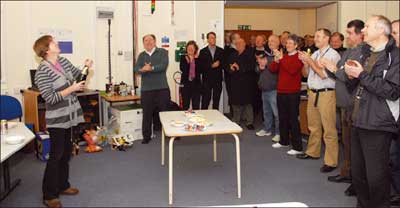At 2.00 a.m. on 13 December 2008, the commissioning team at the ALICE facility of the UK’s Daresbury Laboratory and Cockcroft Institute successfully demonstrated “energy recovery” from a relativistic electron beam at 11 MeV back into the microwave source that powers the linear accelerator. Although the FEL facility and the CEBAF at Jefferson Lab in the US recently demonstrated energy recovery, this is a first for a European team.
ALICE is designed to produce ultrabright and ultrashort pulses of electrons, coherent-synchrotron radiation, FEL and tailored Compton-scattered light, which can be used – in conjunction with modern ultrafast lasers – in cutting-edge experiments in physical and life sciences. At the same time, accelerator research at the facility could revolutionize the way that high-energy particle accelerators, colliders and accelerator-based photon- and neutron-research facilities are designed in the future. A major design goal is to achieve efficient energy recovery (i.e. the repeated exchange and recycling of energy between particles and microwaves). This is a critical requirement for both the scientific reach in beam brightness and the economic viability and affordability of future high-power, high-energy particle accelerators. High-energy beams from ALICE will also be used to explore technology for new cancer treatments in a linked demonstration project known as EMMA.
After more than four years of planning and construction, ALICE achieved its first high-energy beam at 12.54 a.m. on 24 October in the 4 MeV booster. This consists of a superconducting accelerator cavity fed by a photoinjector. The photoinjector is a high-brightness electron gun capable of generating extremely short pulses of electrons, which are fired into the booster at a rate of 81 million shots a second.

At 5.00 p.m. on 7 December, after the booster had accelerated the high-quality electron beam from the photoinjector to 4 MeV, the commissioning team took the beam from the booster up to relativistic energies of 11 MeV in a linear superconducting microwave accelerator (figure 1). The stage was then set for the final act, where the beam is threaded through 360° of beam-transport systems back to the start of the same linac. By recirculating in the opposite microwave phase, the beam undergoes deceleration to achieve energy recovery, where the energy used to accelerate the beam can be recovered and reused after each circuit of the machine.

All figures courtesy STFC Daresbury.
Less than a week later, at 2.00 a.m. on 13 December, the superconducting linac accelerated electrons to a total energy of 11 MeV and the beam was successfully sent round the total circuit, demonstrating energy recovery for the first time outside the US. At 10.50 p.m. on 20 December, energy recovery was achieved at 20.8 MeV (figure 2).

The next stage will be to commission the facility to its full operating energy of 35 MeV.
• ALICE is financed by the UK’s Science and Technology Facilities Council with seed funding from the North West Development Agency. It is operated by the ASTeC team within the Cockcroft Institute which is developing its advanced accelerator-research programme.





